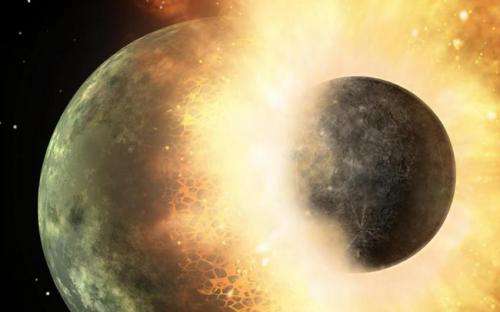New simulations show that Mercury and other unusually metal-rich objects in the solar system may be relics left behind by hit-and-run collisions in the early solar system. Credit: NASA/JPL/Caltech
(Phys.org) —A pair of researchers with Arizona State University has created computer simulations that show that Mercury may have a relatively large metal core because it was the victim of a hit-and-run collision with another proto-planet—a collision that resulted in much of its non-metallic mantle being stripped away by the larger body. In their paper published in the journal Nature Geoscience, Erik Asphaug and Andreas Reufer describe how they ran many computer simulations designed to better understand planet formation in our solar system, and found that under just the right circumstances, a glancing blow collision between proto-Mercury and another proto-planet could have resulted in the current makeup of Mercury.
Mercury, as every school kid knows, is the planet in our solar system closest to the sun. It's also an anomaly because its core makes up approximately 60 percent of its mass (as compared to just 30 percent for Mars, Venus and Earth). Scientists have proposed theories to explain such an oddity, usually suggesting a collision of some sort must have taken place. A normal impact would have resulted in a loss of lighter elements, however, thus it's been difficult to make such theories work. To better understand what might have happened Asphaug and Reufer ran computer simulations that showed a proto-Mercury colliding with various sized planets at various speeds and angles. They found that if a planet about the size of modern Earth collided with proto-Mercury at just the right angle and speed, it would have been possible for proto-Mercury to lose a large portion of its mantle due to it being stripped away. Furthermore, they noted that such an impact would not result in the proto-Mercury being caught in the larger planet's gravity, effectively turning it into a moon. Such a collision, they also note would have resulted in much of the material ejected into space falling back to the target body, resulting in it being more metal rich than before the impact.
Simulations can't prove what happened of course, especially when they are used to describe theoretical events that occurred so long ago, but because they are based on known factors such as the current state of the planets in our solar system and data from spacecraft such as MESSENGER that entered Mercury's orbit back in 2012, they can offer scientists realistic options to consider when studying planetary evolution.
More information: Mercury and other iron-rich planetary bodies as relics of inefficient accretion, Nature Geoscience (2014) DOI: 10.1038/ngeo2189
Abstract
Earth, Venus, Mars and asteroids such as Vesta and, perhaps, Lutetia have chondritic bulk compositions with massive silicate mantles surrounding iron cores. Anomalies include Mercury with its abundant metallic iron (about 70% by mass), the Moon with its small iron core, and metal-dominated asteroids. Although a giant impact with proto-Earth can explain the Moon's small core, a giant impact origin for Mercury is problematic. Such a scenario requires that proto-Mercury was blasted apart with far greater specific energy than required for lunar formation, yet retained substantial volatile elements and did not reaccrete its ejected mantle. Here we present numerical hydrocode simulations showing that proto-Mercury could have been stripped of its mantle in one or more high-speed collisions with a larger target planet that survived intact. A projectile that escapes the planet-colliding orbit in this hit-and-run scenario7 ultimately finds a permanent sink for its stripped mantle silicates. We show that if Mars and Mercury are derived from two planetary embryos that randomly avoided being accreted into a larger body, out of 20 original embryos (the rest having accreted into Venus and Earth), then it is statistically probable that one of those had its mantle stripped in one or two hit-and-run collisions. The same reasoning applies to pairwise accretion of planetesimals in the early Solar System, in which the relic bodies, which avoided becoming accreted, would be expected to have a wide diversity of compositions as a consequence of hit-and-run processes.
Journal information: Nature Geoscience
© 2014 Phys.org
























